
Historically, the Emperors of China especially of the Qing dynasty have promoted Tibetan Buddhism for the purpose of national unity and harmony in the vast country of China. To that end, the Emperors established and cultivated a close relationship with Tibet, especially with the Dalai Lamas, Panchen Lamas and the Changkya Lamas (Kyabje Pabongka Rinpoche’s previous incarnations) from the Gelugpa sect.
The Tibetans believe the emperors of China are emanations of Manjushri and it is no surprise that Dorje Shugden incarnated as the legendary Emperor Kangxi. It also continues to be a strong belief among the Tibetans that their own leader – the Dalai Lama – is an emanation of Chenrezig.
All three thangkas depict Emperor Qianlong as the central figure. The inscription on the top left thangka proclaims Qing Emperor Qianlong as Manjushri, the ruler of the Buddhist faith. These Tibetan thangkas reflect upon the political strategy of the Qing Emperor Qianlong as well as his personal religious beliefs.
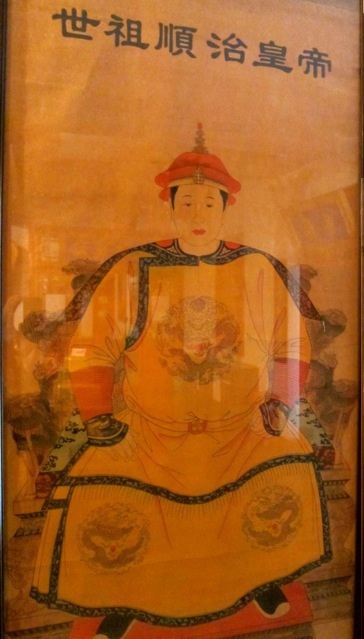
Emperor Shunzhi
The Emperor Shunzhi (March 15, 1638–February 5, 1661) was the first Qing emperor to rule over China proper from 1644 to 1661. As a strategic move to affirm control of Tibet, Emperor Shunzhi invited the fifth Dalai Lama to Beijing in 1652 and treated him with great respect and political decorum befitting the head of an independent state.
The Emperor also granted him an honorific title, a golden certificate of appointment, and a golden seal of authority.
The Great Fifth Dalai Lama had a very strong relationship with the Chinese Emperor Shunzhi and the imperial court. When the Great Fifth paid a two-month visit to Beijing in 1652, the Qing court had built the Huangsi Monastery to accommodate him.
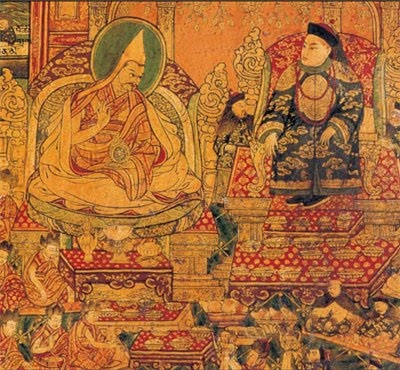
Meeting Between Emperor Shunzhi and the Great Fifth Dalai Lama
In addition, Emperor Shunzhi feasted with the Great Fifth in the Hall of Grand Harmony in the Forbidden City.
After the Great Fifth’s two-month visit, the emperor also granted him an honorific title, a golden certificate of appointment and a golden seal of authority as well as expensive gifts. This incident set a precedent for future Dalai Lamas to officially receive their post from the imperial court.
It is interesting that this painting of the 5th Dalai Lama and the Emperor Shunzhi are found not on the walls of Chinese palaces, but in the Dalai Lama’s Potala Palace in Lhasa, Tibet.
Do note that the Chinese emperor is clearly depicted to be sitting higher than the Dalai Lama – a sign of the deference and respect which the Tibetans paid to the Chinese royalty.
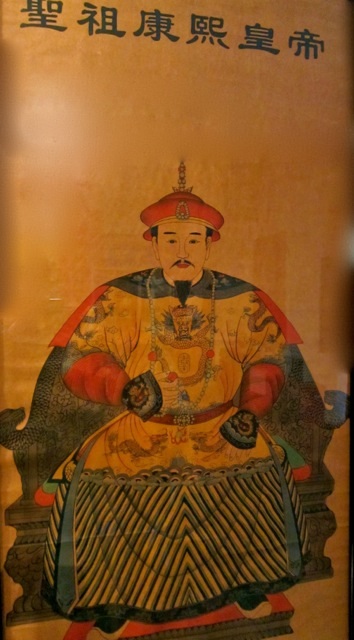
Emperor Kangxi
Emperor Kangxi of China (May 4, 1654 – December 20, 1722) was the second Qing emperor to rule over all of China for 61 years, from 1661 to 1722.
As well as being known as the longest-reigning Emperor of China, he was also known as one of the greatest Chinese emperors for bringing peace and prosperity to the vast country.
Emperor Kangxi united his court and was a skilful military strategist. He was also known for having unusual great compassion for the common people who suffered because of military conflict.
These distinctive qualities of Emperor Kangxi may be explained by Sumpa Khenpo’s Chronology of Tibet for the Wood Sheep year (1655–1656), which stated that “The Kangxi Emperor [is born and] becomes famous as the reincarnation of Tulku Dragpa Gyaltsen (Dorje Shugden).
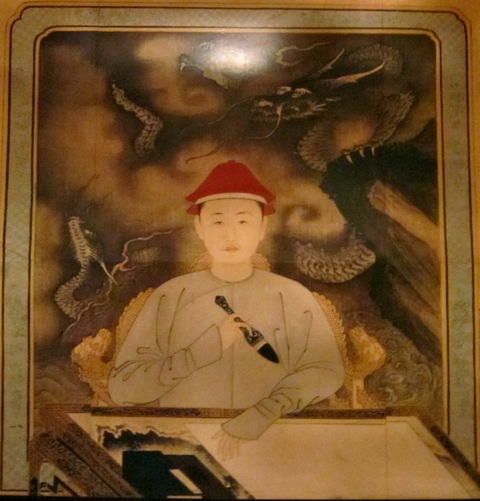 Emperor Kangxi’s contribution was not only towards China, but also towards the growth of Buddhism in Tibet. Emperor Kangxi sponsored the 7th Dalai Lama Kelzang Gyatso’s entrance into Kumbum Monastery, and bestowed the golden seal of authority upon him.
Emperor Kangxi’s contribution was not only towards China, but also towards the growth of Buddhism in Tibet. Emperor Kangxi sponsored the 7th Dalai Lama Kelzang Gyatso’s entrance into Kumbum Monastery, and bestowed the golden seal of authority upon him.
This close relationship between Emperor Kangxi and the Dalai Lama shows the close relationship between China and Tibetan Buddhism which has endured over time.

Emperor Yongzheng
The Emperor Yongzheng (December 13, 1678 – October 8, 1735) was the third Qing emperor to rule over China, from 1722 to 1735.
Though he is less well-known than his father, the Emperor Kangxi, and his own son, the Emperor Qianlong (乾隆), the Emperor Yongzheng was an energetic and capable ruler.
He continued his father’s legacy of harmony and development in China by continuing the policy of respecting Lamaism, seeking unity with Tibetan and Mongolian minorities.
A man of principle, he was strongly against corruption and any officials found to be transgressors were punished severely.
The Emperor Qianlong (September 25, 1711 – February 7, 1799) was the fourth Qing emperor to rule over China. The fourth son of the Yongzheng Emperor, he reigned officially from October 18, 1735 to February 9, 1796.
During the reign of Emperor Qianlong, China attained its maximum territorial expanse; from Xinjiang in the west, to Myanmar and Annam in the south. Emperor Qianlong sent armies into Tibet and firmly established the Dalai Lama as ruler, with a Qing resident and garrison to preserve Chinese suzerainty.
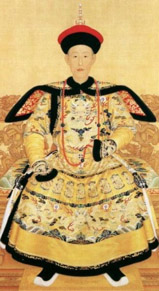
Emperor Qianlong
In 1744, Emperor Qianlong decided to rebuild Yonghegong Palace in Beijing into a Tibetan monastery, which was designed based on the Gelugpa monastic principles.
After being rebuilt into a temple, Yonghegong became the bridge between the central government and local authorities in Tibet and Mongolia, showing an important function both in religious and political areas. Yonghegong also became the center of the central government in handling Tibetan Buddhist affairs.
To this day, Yonghegong remains a popular pilgrimage and tourist site, visited by thousands of Chinese and foreigners alike. The central images of Maitreya, Tsongkhapa and many other antique statues of the Tibetan Buddhist tradition have been extremely well-preserved and stand as stunning centerpieces to this unique and historical religious monument.
The Daoguang (Tao-kuang) Emperor (September 16, 1782 – February 25, 1850) was the sixth Qing emperor to rule over China.
The following incident was described in HH Trijang Rinpoche’s Music Delighting an Ocean of Protectors. Resident in Tibet was a powerful high Chinese minister named Amben Che Trungtang.
He had some very important questions to ask for Dorje Shugden’s prophecy and came to the Lhasa Trode Kangsar Protector Palace and, in front of the image of the Dharmapala, burned the questions he had written in Chinese, and demanded that the Dharmapala give clear prophesies in answer to his questions during an invocation the following day.
When Dorje Shugden was invoked the next day, he gave explicit powerful answers to the questions in the correct order. Trungtang, with delighted conviction, informed the Emperor Dao Guang who awarded a proclamation of praise to Gyalchen (Dorje Shugden) of the Trokang Temple with a pandit’s hat. There, in the center of a large stone courtyard, inside a pitched tent, in an elaborate auspicious ceremony, over the door of the protector palace was offered the pandit’s award.
The Trokang oracle, the temple monks, and general chief monks, with the regent Ratreng Rinpoche, the Chinese Amban, the Kashag, and Shabpa as chief attendees, Tibetan and Chinese people of all ranks were offered a feast and had a huge festival.
With the Chinese Emperor Daoguang and the Lord of Buddhas, the Dalai Lama, patron and lama together, they all praised and enthroned Gyalchen Dorje Shugden as principal protector of the Yellow Hat Teachings.








































 English
English Indonesia
Indonesia Tibetan
Tibetan
Agnes Kohl
April 22, 2012
In traditional schools’ history classes this will never be studied. So I most grateful to have read this article here. If the relationship among Emperors, Dalai Lamas and Dorje Shugden can be traced all the way back 17th Century, it simply proves that China is Buddhist, there is no conflict between state and religion, and Dorje Shugden was the Protector.
Looking at today, the changes are – Imperial China no longer exists. China is controlled by a Communist Government and is a growing economic power. The Dalai Lama is not China’s friend and Dorje Shugden is growing in China even though religion is a very sensitive matter in China and public display is prohibited. Dorje Shugden grows in China because Dalai Lama is prohibiting it.
Unlike the Emperors of the past, the China government makes no proclamation nor gives any official seal of recognition to Dorje Shugden but the fact that his monasteries can continue in China is acceptance the China way. It makes me think if this is not one whole cycle of life – Tibetan Buddhism returns to China through the growth of Dorje Shugden and because this practice has been banned and is done in secret it would fit China’s policy of no public displays or threats to national security.
Pulling the Dalai Lama back into this equation – He is really Chenrezig. By banning the practice of Dorje Shugden he has made it “attractive” for China. And because his practice is “illegal” the practitioners are cautious and this too suits China. How skillful and far sighted! A little indirect and much controversy to reach this end, but I guess with today’s dynamics in the world it is a skillful method.
Rinchen
August 7, 2013
This article has shown the close relationship that ancient China has with Tibetan Buddhism. It shows how much respect the Chinese Royalty had for Tibetan Buddhism, as well as Dorje Shugden.
Through this ban, it has allowed China to be practicing both Buddhism and Dorje Shugden again. This is because since the Dalai Lama claims that doing Dorje Shugden practices would harm both the Dalai Lama, and the cause for free Tibet, hence, the Chinese government highly promotes Dorje Shugden practices. With the backing of the Chinese government and the ban, it has made Dorje Shugden very popular among all Tibetan Buddhism practitioners. It has also allowed both Tibetan Buddhism and Dorje Shugden practice to be well known and well spread around the world.